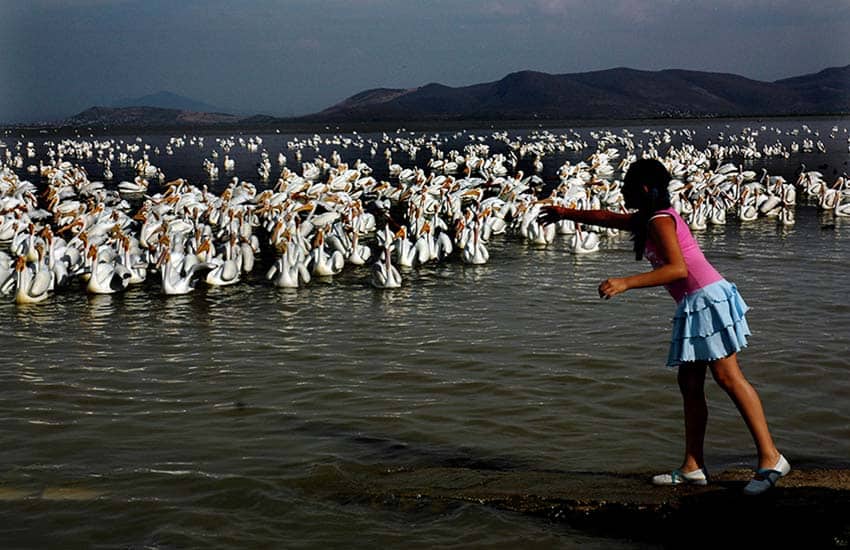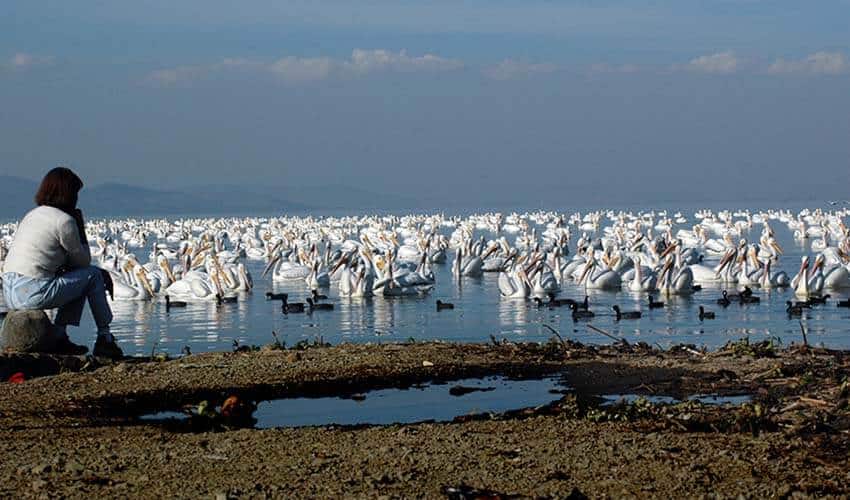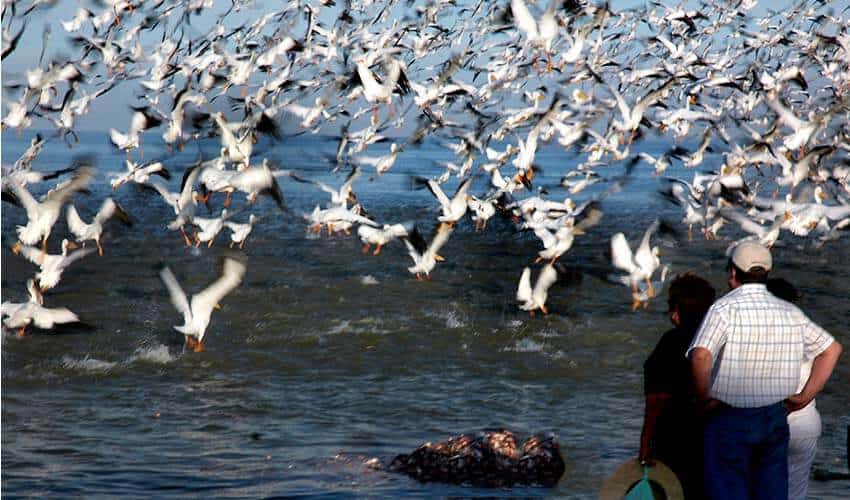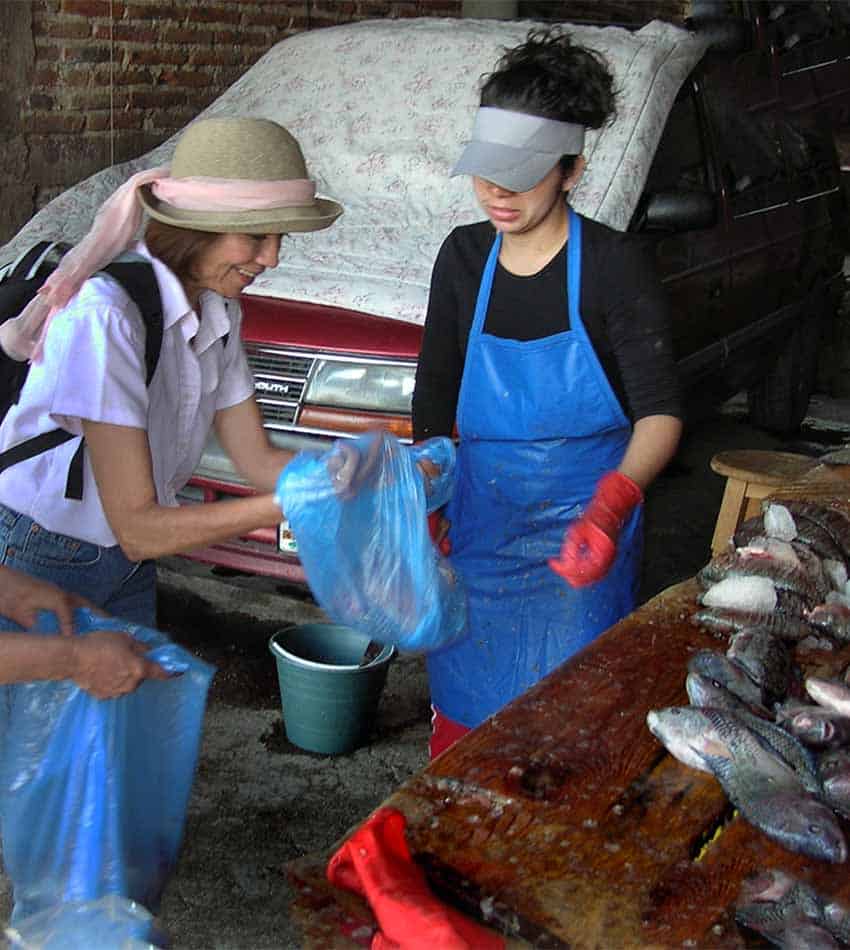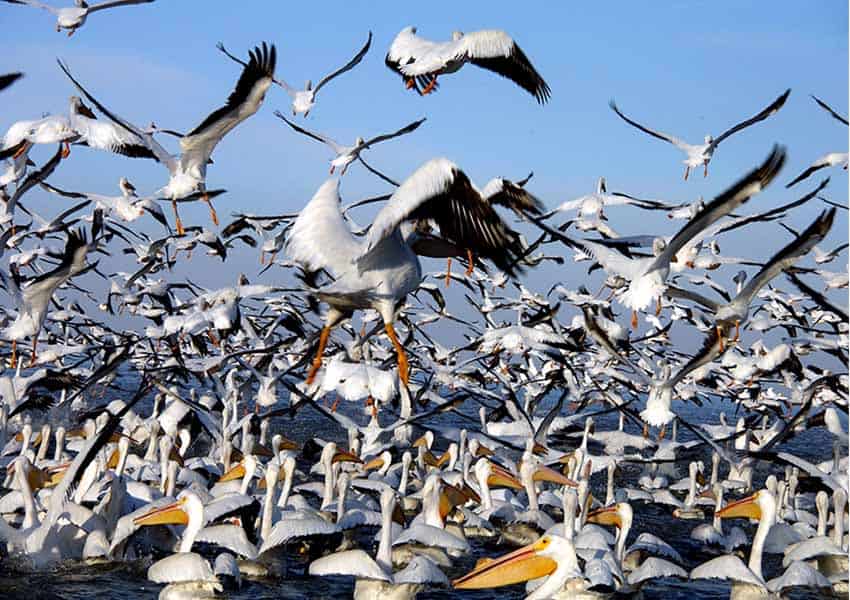“Antes de petatearte, hay que ir a Petatán,” I was once told by an inhabitant of that small town tucked away at Lake Chapala’s eastern end in Michoacán.
This means “Before they roll you up in a petate, you must visit Petatán,” referring to the pre-Hispanic custom of rolling up a cadaver for burial in a thin sleeping mat (petate) made of reeds that grow along the shores of most Mexican lakes.
I wholeheartedly agree with this saying because little Petatán, Michoacán, offers visitors an experience quite unlike any other each year: the arrival of 10,000–20,000 American white pelicans who migrate south from Canada.
The arrival of the monarch butterflies in Michoacán is something marvelous, but the sight and sound of 10,000 huge, white birds rising into the air all at once here is truly a unique spectacle.
Ana Manso, the mayor of nearby Cojumatlán de Régules, says, “Everyone knows the phenomenon of the monarch butterfly, but the pelicans are a bit forgotten.”

Mayor Manso is reminding the world that March is your last month to see what she and all the local people refer to as los pelícanos borregones, “the flying white sheep.”
They have this moniker not only because of their habit of doing everything together but also because Pelecanus erythrorhynchos is really big — the largest flying bird in Mexico.
American white pelicans live and breed at several Canadian lakes. Every year, they make a nearly 4,000-kilometer journey south to their favorite haunts in the United States, Mexico and Central America, and for decades, Lake Chapala has been among their favorite places to winter.
Why? No doubt because of the huge quantities of fish scraps dumped into the lake at the end of every workday by several filleting maquiladoras (factories) that process fish imported from Guanajuato and México state.
Several hours before feeding time, the pelicans begin to make their way toward Petatán from all over Lake Chapala. They appear in the distance like white, black-fringed ribbons in the sky.
Despite their weight (up to seven kilos), their flight is utterly graceful and they love soaring inches above the water for long distances. Not quite so graceful is their landing technique, which involves sticking their feet out straight in front of them as they hit the water: a braking maneuver as comical as it is effective.

The workers of Petatán and Cojumatlán de Régules shovel truckloads of stripped fish into the water every day, and thousands of pelicans show up for the feast. One might expect the result to be an absolute madhouse of squabbling birds and flying feathers. Instead, they patiently wait their turn in line like Englishmen in a bus queue.
This sounds unbelievable, but as I observed the feeding procedure, I saw that each bird eats two fish — neither more nor less — and then instantly turns around and leaves. This process makes for maximum buffet-style efficiency except for the occasional interruption when a motorboat appears.
The flying sheep then become a flying carpet that instantly rises straight into the air with an audible whoosh, filling the sky with thousands of birds. It’s a sound and sight you’ll never forget!
This mass pelican feed takes place between 4 p.m. and 5 p.m., Monday through Saturday. Amazingly, they don’t show up on Sundays, when the maquiladoras are closed.
“How do they know it’s Sunday?” I asked one of the men shoveling fish into the lake.
“No tengo ni idea,” was the reply, but when I put the same question to naturalist-photographer Jesús Moreno, he gave me an odd look.

“Why do you suppose they can’t count?” he asked. “They have a better sense of the passage of time, of the sequence of days and nights, than you do.”
So you now have an even more compelling reason to go see the real snowbirds in Petatán: not only are they beautiful, they are smart as well.
The American white pelican’s wingspan, which can reach as long as three meters (9.8 feet) is the second largest of any North American bird after the California condor, according to the United States Fish and Wildlife Service. These huge creatures can measure up to 1.75 meters (5.7 feet) in length. When no fish filleters are around to give them a free lunch, they work cooperatively to find food.
Unlike their brown cousins who employ kamikaze-like dives to catch fish, white pelicans coordinate their swimming to drive schooling fish toward the shallows. Once the fish are corralled, the pelicans easily scoop them up in their massive beaks.
Says Tony Burton, who wrote a must-have guide to the state of Jalisco: “It is great fun watching them fan out into a semicircle and then slowly close in on lunch, dipping their cavernous beaks into the water at the same time in perfect synchronicity. There is a clear lesson here for us: working together is far more efficient than working independently.”
Another curious thing about these pelicans: they have no call or song but instead have developed complex gestures to communicate.
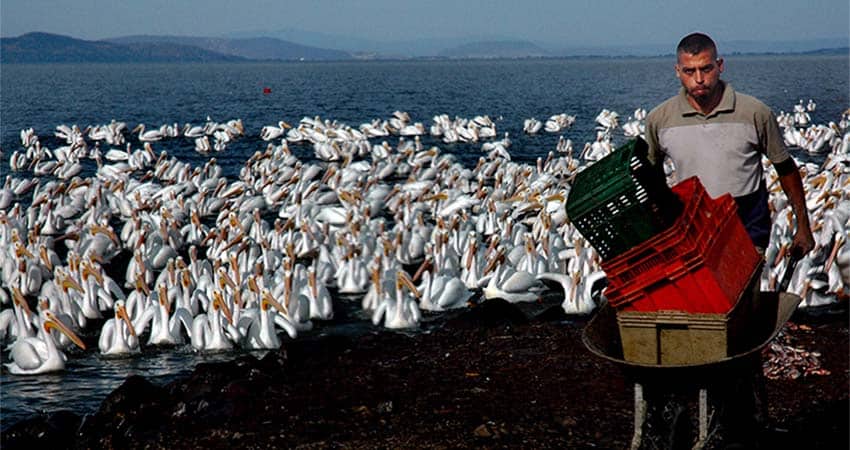
As chicks, however, they squawk inside the egg, expressing discomfort if conditions are too hot or cold. After hatching, they crawl within two weeks and walk by three. The moment they hit the water they can swim.
As for flying, they start out running about while flapping their wings, and then, at around 10 weeks, they take to the air.
From Guadalajara, the most restful and picturesque road to Petatán is Highway 15, a drive of little more than two hours.
Since the pelicans eat between 4 p.m. and 5 p.m., you might end up driving home in the dark, so I suggest instead you spend the night at Igloo Kokolo, located just a half hour from Petatán.
You might find sleeping in their super-adobe “igloo” almost as unique as encountering 10,000 pelicans. And with its near-perfect Airbnb rating of 4.97 stars, you can expect a great night’s sleep.
If you’d rather not drive at all, owner Salvador “Chava” Montaño assures me that he can arrange for transportation not only to and from Petatán but also between Guadalajara and Igloo Kokolo, given a bit of lead time. Call him from 9 a.m. to 7 p.m. at 376-690-0915 or message him at 331-835-8026 or 331-903-8629 — and, yes, he speaks English!

Don’t wait too long! The pelicans leave around the beginning of April, but it could be a lot sooner. Contrary to what you would expect, say Petatán residents, the pelicans eat little the day before their departure.
Early the next morning at sunrise, after a winter of fun in the sun and free meals, they spiral up into the air in long, orderly queues of 500 or so and start their 3,876-kilometer journey back to British Columbia, Alberta, Ontario and Manitoba.
The writer has lived near Guadalajara, Jalisco, since 1985. His most recent book is Outdoors in Western Mexico, Volume Three. More of his writing can be found on his blog.
